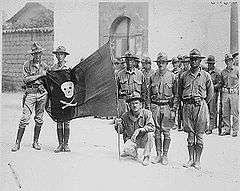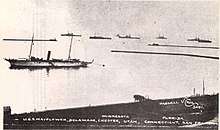Banana Wars
The Banana Wars were occupations, police actions, and interventions on the part of the United States in Central America and the Caribbean between the end of the Spanish–American War in 1898 and the inception of the Good Neighbor Policy in 1934.[1] These military interventions were most often carried out by the United States Marine Corps, which developed a manual, The Strategy and Tactics of Small Wars (1921) based on its experiences. On occasion, the Navy provided gunfire support and Army troops were also used.
| Banana Wars | |
|---|---|
 United States Marines and a Haitian guide patrolling the jungle in 1915 during the Battle of Fort Dipitie | |
| Objective | To protect United States interests in Central America and Caribbean |
| Date | 1898–1934 |
| Executed by | United States |
| Outcome |
|
With the Treaty of Paris, Spain ceded control of Cuba, Puerto Rico, Guam, and the Philippines to the United States. Thereafter, the United States conducted military interventions in Cuba, Panama, Honduras, Nicaragua, Mexico, Haiti, and the Dominican Republic. The series of conflicts ended with the withdrawal of troops from Haiti in 1934 under President Franklin D. Roosevelt.
The term was popularized in 1983[2] by writer Lester D. Langley. Langley wrote several books on Latin American history and American interactions including The United States and the Caribbean, 1900–1970 and The Banana Wars: An Inner History of American Empire, 1900–1934. His book on the Banana Wars encompasses the United States tropical empire that overtook the western hemisphere spanning both of the Roosevelt presidencies. The term was popularized through this writing which portrayed the United States as a police force that was sent to reconcile warring tropical countries, lawless societies and corrupt politicians, establishing a reign over tropical trade.
Origins

U.S. motivations for these conflicts were largely economic and military. The term "Banana Wars" was coined much later to cast the motivations for these interventions as almost exclusively the preservation of U.S. commercial interests in the region.
Most prominently, the US was advancing its economic, political, and military interests to maintain its sphere of influence and securing the Panama Canal (opened in 1914) which it had recently built to promote global trade and to project its own naval power. US companies such as the United Fruit Company also had financial stakes in the production of bananas, tobacco, sugar cane, and other commodities throughout the Caribbean, Central America and northern South America.
Interventions

- Panama: U.S. interventions in the isthmus go back to the 1846 Mallarino–Bidlack Treaty and intensified after the so-called Watermelon War of 1856. In 1885 US military intervention gained a mandate with the construction of the Panama Canal. The building process collapsed in bankruptcy, mismanagement, and disease in 1889, but resumed in the 20th century.[2] In 1903, Panama seceded from the Republic of Colombia, backed by the U.S. government,[lower-alpha 1] during the Thousand Days' War. The Hay–Pauncefote Treaty allowed the US to construct and control the Panama Canal. In 1903 the United States established sovereignty over a Panama Canal Zone.
- Spanish–American War: U.S. forces seized Cuba and Puerto Rico from Spain in 1898. The end of the Spanish–American War led to the start of Banana Wars.
- Cuba: In December 1899 US president William McKinley deemed Leonard Wood to have supreme power in Cuba.[4] The U.S. conquered Cuban from the Spanish Empire. Occupied by the U.S. from 1898 to 1902 under military governor Leonard Wood, and again from 1906 to 1909, 1912, and 1917 to 1922; subject to the terms of the Cuban–American Treaty of Relations (1903) until 1934. In 1903 the US took a permanent lease on the Guantanamo Bay Naval Base.
- Dominican Republic: Action in 1903, 1904 (the Santo Domingo Affair), and 1914 (Naval forces engaged in battles in the city of Santo Domingo[5]); occupied by the U.S. from 1916 to 1924.
- Nicaragua: Occupied by the U.S. almost continuously from 1912 to 1933, after intermittent landings and naval bombardments in the prior decades. The U.S. had troops in Nicaragua to prevent its leaders from creating conflicts with U.S. interests in the country. The bluejackets and marines were there for about 15 years.[2] The U.S. claimed it wanted Nicaragua to elect "good men", who ostensibly would not threaten to disrupt U.S. interests.[2]
- Mexico: U.S. military involvements with Mexico in this period had the same general commercial and political causes, but stand as a special case. The Americans conducted the Border War with Mexico from 1910–1919 for additional reasons: to control the flow of immigrants and refugees from revolutionary Mexico (pacificos), and to counter rebel raids into U.S. territory. The 1914 U.S. occupation of Veracruz, however, was an exercise of armed influence, not an issue of border integrity; it was aimed at cutting off the supplies of German munitions to the government of Mexican leader Victoriano Huerta,[6] which U.S. President Woodrow Wilson refused to recognize.[6] In the years prior to World War I, the U.S. was also alert to the regional balance of power against Germany. The Germans were actively arming and advising the Mexicans, as shown by the 1914 SS Ypiranga arms-shipping incident, German saboteur Lothar Witzke's base in Mexico City, the 1917 Zimmermann Telegram and the German advisors present during the 1918 Battle of Ambos Nogales. Only twice during the Mexican Revolution did the U.S. military occupy Mexico: during the temporary occupation of Veracruz in 1914 and between 1916 and 1917, when U.S. General John Pershing led U.S. Army forces on a nationwide search for Pancho Villa.
- Haiti, occupied by the U.S. from 1915–1934, which led to the creation of a new Haitian constitution in 1917 that instituted changes that included an end to the prior ban on land ownership by non-Haitians. This period included the First and Second Caco Wars.[7]
- Honduras, where the United Fruit Company and Standard Fruit Company dominated the country's key banana export sector and associated land holdings and railways, saw insertion of American troops in 1903, 1907, 1911, 1912, 1919, 1924 and 1925. The writer O. Henry coined the term "Banana republic" in 1904 to describe Honduras.[8]
Other Latin American nations were influenced or dominated by American economic policies and/or commercial interests to the point of coercion. Theodore Roosevelt declared the Roosevelt Corollary to the Monroe Doctrine in 1904, asserting the right of the United States to intervene to stabilize the economic affairs of states in the Caribbean and Central America if they were unable to pay their international debts. From 1909–1913, President William Howard Taft and his Secretary of State Philander C. Knox asserted a more "peaceful and economic" Dollar Diplomacy foreign policy, although that too was backed by force, as in Nicaragua.
American fruit companies
The first decades of Honduras' history is marked by instability in terms of politics and economy. Indeed 210 armed conflicts occurred between independence and the rise to power of the Carias government.[9] This instability was due in part to the American involvement in the country.[9]
The first company that concluded an agreement with the Honduras government was the Vaccaro Brothers Company (Standard Fruit Company).[9] The Cuyamel Fruit Company then followed their lead. United Fruit Company also contracted with the government through its subsidiaries, Tela Railroad Company and Truxillo Rail Road Company.[9]
Contract between the Honduran government and the American companies most often involved exclusive rights to a piece of land in exchange for building railroads in Honduras.[9]
However, banana producers in Central America (including Honduras) "were scourged by Panama disease, a soil-borne fungus (…) that decimated production over large regions".[10] Typically, companies would abandon the decimated plantations and destroy the railroads and other utilities that they had used along with the plantation,[10] so the exchange of services between the government and the companies was not always respected.
The ultimate goal of the contracts for the companies was control of the banana trade from production to distribution. The companies would finance guerrilla fighters, presidential campaigns and governments.[9] According to Rivera and Carranza, the indirect participation of American companies in the country's armed conflicts worsened the situation.[9] The presence of more dangerous and modern weapons allowed more dangerous warfare among the factions.[9]
In British Honduras (modern-day Belize) the situation was significantly different. Despite the fact that the United Fruit Company was the sole exporter of bananas there and the company was also attempting to manipulate the local government, the country did not suffer the instability and armed conflicts its neighbors experienced.[10]
Notable veteran
Perhaps the single most active military officer in the Banana Wars was U.S. Marine Corps Major General, Smedley Butler, nicknamed "Maverick Marine", who saw action in Honduras in 1903, served in Nicaragua enforcing American policy from 1909 to 1912, was awarded the Medal of Honor for his role in Veracruz in 1914, and a second Medal of Honor for bravery in Haiti in 1915. Butler gave a speech in 1933 across the US titled War is a Racket, where he denounced the role he had played, describing himself as "a high class muscle man for Big Business, for Wall Street and the bankers...a racketeer, a gangster for capitalism".[11] In 1935, he adapted that speech into a published book.
See also
Notes
- In December 1903, President Roosevelt put the number of "revolutions, rebellions, insurrections, riots, and other outbreaks" in Panama at 53 in the space of 57 years.[3]
References
- Gilderhusrt, Mark T. (2000). The Second Century: U.S.–Latin American Relations Since 1889. Rowman & Littlefield. p. 49.
- Langley, Lester D. (1983). The Banana Wars: United States Intervention in the Caribbean, 1898–1934. University Press of Kentucky. p. 3. ISBN 0-8131-1496-9.
- Roosevelt, Theodore (December 7, 1903). – via Wikisource.
- Musicant, Ivan (1991). The Banana Wars: A History of United States Military Intervention in Latin America from the Spanish–American War to the Invasion of Panama. New York: Macmillan.
- "US Military and Clandestine Operations in Foreign Countries – 1798–Present".
- "Mexican Revolution: Battle of Veracruz". Militaryhistory.about.com. August 4, 2015. Retrieved March 17, 2016.
- Hubert, Giles A. (January 1947). "War and the Trade Orientation of Haiti". Southern Economic Journal. 13 (3): 276–84. JSTOR 1053341.
- Economist explains (November 21, 2013). "Where did banana republics get their name?". economist.com. Retrieved February 16, 2016.
- Miguel Cáceres Rivera and Sucelinda Zelaya Carranza, "Honduras. Seguridad Productiva y Crecimiento Econoómico: La Función Económica Del Cariato," Anuario de Estudios Centroamericanos, Vol. 31 (2005), pp. 49–91.
- Mark Moberg, "Crown Colony as Banana Republic: The United Fruit Company in British Honduras, 1900–1920," Journal of Latin American Studies, Vol. 28, No. 2 (May 1996), pp. 357–381.
- Butler, Smedley (1933). War is a Racket (Speech). US.
External links
